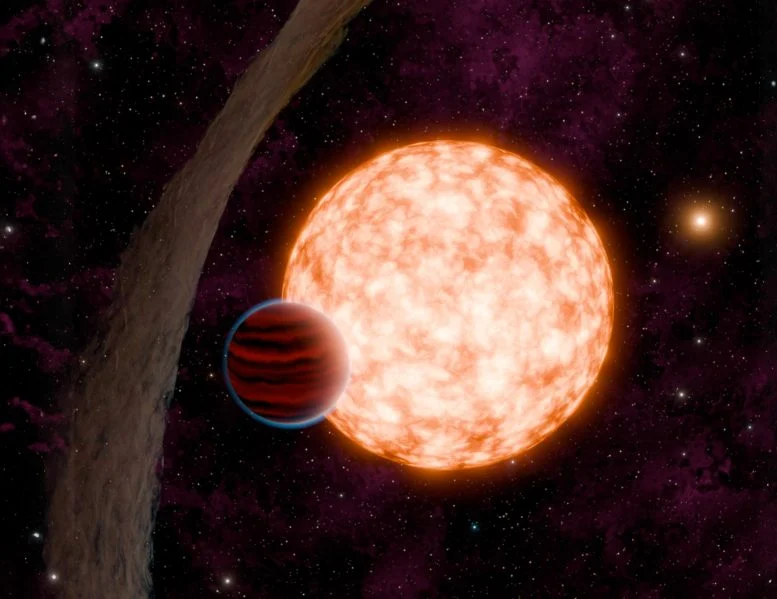
By NASA December 1, 2024
Collected at: https://scitechdaily.com/how-a-warped-disk-exposed-a-hidden-baby-planet/
A young exoplanet named IRAS 04125+2902 b, only 3 million years old and located in the Taurus Molecular Cloud, is revealed through a lucky observation despite usually hidden by debris.
The planet shows a low density but similar size to Jupiter, suggesting it might evolve into a mini-Neptune or super-Earth.
Discovery of a Young Exoplanet
A massive planet with the unwieldy name IRAS 04125+2902 b is, surprisingly, just a baby at only 3 million years old. This makes it the youngest planet ever discovered using the widely-used “transit method” of detection. Such infant worlds are typically hidden behind thick disks of debris, making them incredibly hard to observe.
This young exoplanet resides in the Taurus Molecular Cloud, a stellar nursery teeming with hundreds of newborn stars about 430 light-years away. Its proximity makes it an ideal focus for astronomers studying star and planet formation. While the cloud provides a wealth of data on young stars, observing their planets is far more challenging. Telescopes like TESS (Transiting Exoplanet Survey Satellite) rely on detecting small dips in starlight caused by a planet crossing in front of its host star. However, for this method to work, the planet’s orbit must be aligned edge-on from Earth’s perspective. In young star systems, debris disks often block this view, making it difficult to spot any transiting planets.
Fortuitous Observations Amidst Cosmic Challenges
A research team has just reported an extraordinary stroke of luck. Somehow, the outer debris disk surrounding this newborn planet, IRAS 04125+2902 b, has been sharply warped, exposing the baby world to extensive transit observations by TESS.
While the warped outer disk is a great coincidence, it’s also a great mystery. Possible explanations include a migration of the planet itself, moving closer to the star and, in the process, diverging from the orientation of the outer disk – so that, from Earth, the planet’s orbit is edge-on, crossing the face of the star, but the outer disk remains nearly face-on to us. One problem with this idea: Moving a planet so far out of alignment with its parent disk would likely require another (very large) object in this system. None has been detected so far.
Theories Behind the Warped Disk
The system’s sun happens to have a distant stellar companion, also a possible culprit in the warping of the outer disk. The angle of the orbit of the companion star, however, matches that of the planet and its parent star. Stars and planets tend to take the gravitational path of least resistance, so such an arrangement should push the disk into a closer alignment with the rest of the system – not into a radical departure.
Another way to get a “broken” outer disk, the study authors say, would not involve a companion star at all. Stellar nurseries like the Taurus Molecular Cloud can be densely packed, busy places. Computer simulations show that rains of infalling material from the surrounding star-forming region could be the cause of disk-warping. Neither simulations nor observations have so far settled the question of whether warped or broken disks are common or rare in such regions.
Insights From Combined Observational Methods
Combining TESS’s transit measurements with another way of observing planets yields more information about the planet itself. We might call this second approach the “wobble” method. The gravity of a planet tugs its star one way, then another, as the orbiting planet makes its way around the star. And that wobble can be detected by changes in the light from the star, picked up by specialized instruments on Earth. Such “radial velocity” measurements of this planet reveal that its mass, or heft, amounts to no more than about a third of our own Jupiter.
However, the transit data shows the planet’s diameter is about the same. That means the planet has a comparatively low density and, likely, an inflated atmosphere. So this world probably is not a gas giant like Jupiter. Instead, it could well be a planet whose atmosphere will shrink over time. When it finally settles down, it could become a gaseous “mini-Neptune” or even a rocky “super-Earth.” These are the two most common planet types in our galaxy – despite the fact that neither type can be found in our solar system.
A science team led by astronomer Madyson G. Barber of the University of North Carolina at Chapel Hill published the study, “A giant planet transiting a 3 Myr protostar with a misaligned disk,” in the journal Nature in November 2024.
For more on this discovery, see Youngest Planet Discovery Shatters Planetary Formation Theories.
Reference: “A giant planet transiting a 3-Myr protostar with a misaligned disk” by Madyson G. Barber, Andrew W. Mann, Andrew Vanderburg, Daniel Krolikowski, Adam Kraus, Megan Ansdell, Logan Pearce, Gregory N. Mace, Sean M. Andrews, Andrew W. Boyle, Karen A. Collins, Matthew De Furio, Diana Dragomir, Catherine Espaillat, Adina D. Feinstein, Matthew Fields, Daniel Jaffe, Ana Isabel Lopez Murillo, Felipe Murgas, Elisabeth R. Newton, Enric Palle, Erica Sawczynec, Richard P. Schwarz, Pa Chia Thao, Benjamin M. Tofflemire, Cristilyn N. Watkins, Jon M. Jenkins, David W. Latham, George Ricker, Sara Seager, Roland Vanderspek, Joshua N. Winn, David Charbonneau, Zahra Essack, David R. Rodriguez, Avi Shporer, Joseph D. Twicken and Jesus Noel Villaseñor, 20 November 2024, Nature.

Leave a Reply